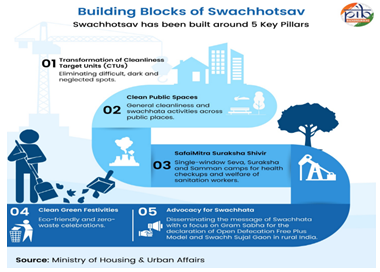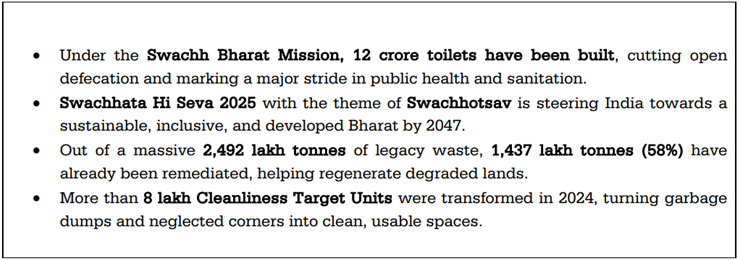

26th September 2025 (13 Topics)
Context:
The Government of India launched Swachhata Hi Seva (SHS) 2025, themedSwachhotsav, as part of the Swachh Bharat Mission (SBM) to intensify waste management, dumpsite remediation, and community participation, marking a decade since SBM’s inception.
Evolution of the Mission
- Genesis of SBM (2014): Launched on Mahatma Gandhi’s birth anniversary to eliminate open defecation and improve sanitation coverage. Over 12 crore toilets built, reducing open defecation drastically.
- Introduction of Swachhata Hi Seva (SHS)(2017): Annual citizen-driven cleanliness drive to ensure behavioural change through Shramdaan (voluntary service).
- Swachhata Hi Seva 2025: A nationwide campaign (17 Sept–2 Oct) involving ministries, citizens, and local bodies with a focus on Antyodaya se Sarvodaya (uplifting the marginalized first).

Achievements and Progress

- Waste Processing Expansion: Waste treatment rose from 16% in 2014 to over 81% in 2025, with 1.29 lakh tonnes processed daily.
- Legacy Waste Remediation: Out of 2,492 lakh tonnes of dumpsite waste, 1,437 lakh tonnes (58%) remediated, reclaiming 7,646 acres of land.
- Community Participation: In 2024, 8 lakh Cleanliness Target Units (CTUs) transformed; SHS 2025 emphasises beautification and eco-friendly urban spaces.
- Public Health Impact: WHO estimated 3 lakh under-five child deaths prevented due to improved sanitation and hygiene practices.
Challenges and Concerns
- Behavioural Sustainability: Continued citizen participation post-campaign is difficult.
- Solid Waste Segregation: Household-level waste segregation remains below optimal levels, risking landfill resurgence.
- Urban Local Bodies’ Capacity: Many municipalities face funding and manpower shortages, hampering effective waste-to-energy projects.
- Plastic Waste Management: Despite bans, single-use plastic circulation continues in informal markets.
Case Studies of Innovation
- Agra (UP): Reclaimed 47 acres of dumpsite through bioremediation, creating an Integrated Waste Management City.
- Assam: Women turned invasive water hyacinth into handicrafts and startups developed biodegradable paper from the plant.
- Amarnath Yatra (J&K): Zero-landfill, plastic-free pilgrimage with real-time waste processing and faecal sludge treatment.
Way Forward
- Institutional Strengthening: Empower ULBs with financial autonomy, skilled manpower, and modern waste-processing infrastructure.
- Circular Economy Push: Promote recycling industries, incentivise biodegradable product markets, and expand Extended Producer Responsibility (EPR).
- Technology Integration: Use AI, GIS mapping, and blockchain for waste tracking, dumpsite monitoring, and citizen accountability.
- Behavioural Campaigns: Sustained IEC (Information, Education, Communication) efforts to ingrain cleanliness as a cultural norm.
- Inclusive Participation: Recognition and welfare of sanitation workers to ensure dignity of labour.
More Articles



